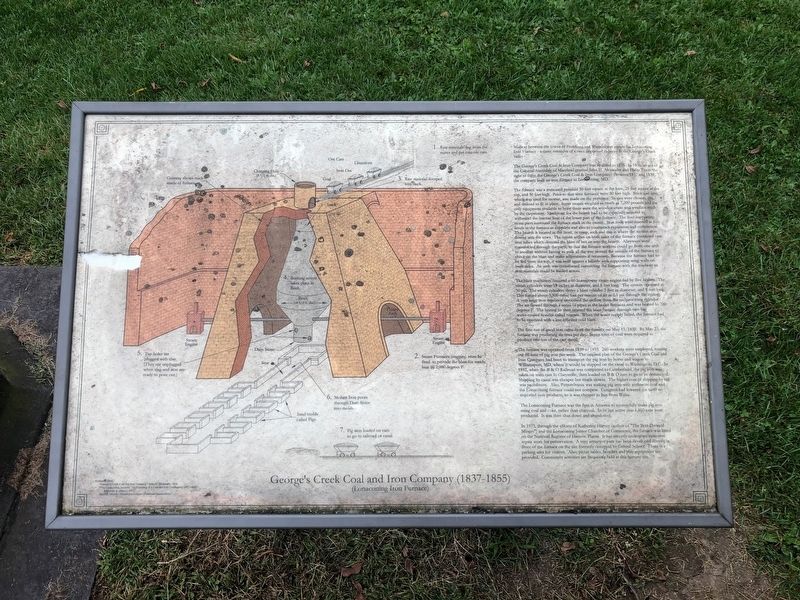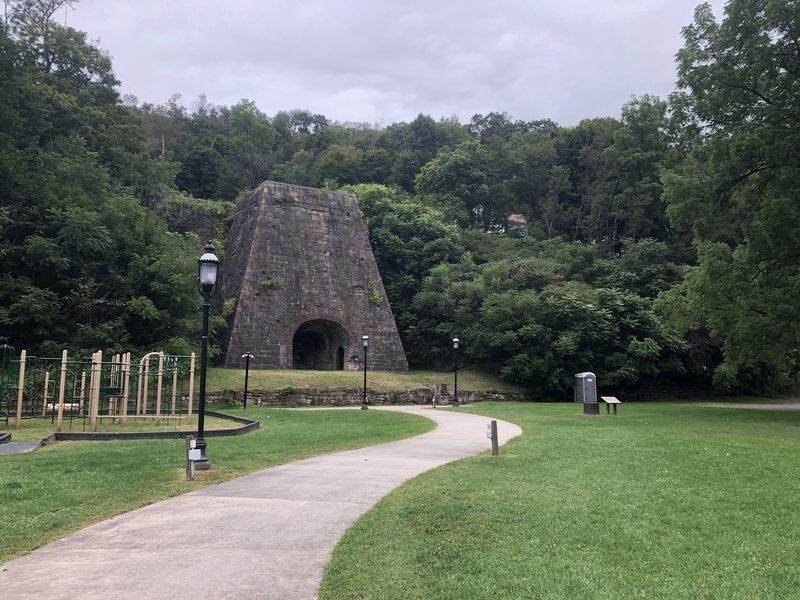Lonaconing in Allegany County, Maryland — The American Northeast (Mid-Atlantic)
George's Creek Coal and Iron Company (1837-1855)
(Lonaconing Iron Furnace)

Photographed By Devry Becker Jones (CC0), September 1, 2019
1. George's Creek Coal and Iron Company (1837-1855) Marker
The George's Creek Coal & Iron Company was founded in 1835. In 1836, an act of the General Assembly of Maryland granted John H. Alexander and Philip Tyson the right to form the George's Creek Coal & Iron Company. Between 1837 and 1839, the company built an iron furnace in Lonaconing, MD.
The furnace was a truncated pyramid 50 feet square at the base, 25 feet square at the top, and 50 feet high. Prior to that time furnace were 30 feet high. Brick and lime, which was used for mortar, was made on the premises. Stones were chosen, cut and dressed to fit in place. Some stones weighed as much as 7,200 pounds and the only equipment available to hoist them were the wooden crane and windlass made by carpenters. Sandstone for the hearth had to be especially selected to withstand the intense heat of the lower part of the furnace. The four supporting stone piers surround the furnace stack in the center. Iron rods were inserted at five levels in the furnace as supports and also to counteract expansion and contraction. The hearth is located in the front, or tymp, and this is where the molten iron flowed into the sows. The tuyere arches on both sides of the furnace contained cast iron tubes which directed the blast of hot air into the hearth. Alleyways were constructed throw the piers, so that the furnace workers could go from one arch to the other without having to walk all the way around the outside of the furnace to check on the blast and make adjustments if necessary. Because the furnace had to be fed from the top, it was built against a hillside with supporting wing walls on both sides. An arch was constructed connecting the furnace with the roadway so that materials could be hauled across.
The blast machinery featured a 60-horsepower steam engine fed by five boilers. The steam cylinders were 18 inches in diameter, and 8 feet long. The system operated at 50 psi. The steam cylinders drove a blast cylinder 5 feet in diameter, and 8 feet long. This forced about 3,500 cubic feet per minute of air at 2.5 psi through the system. A very large iron regulator smoothed the airflow from the reciprocating cylinder. The air flowed through a series of pipes in the boiler furnaces and was heated to 700 degrees F. The heated air then entered the blast furnace through two big water-cooled nozzles called tuyeres. When the water supply failed, the furnace had to be operated with a less efficient cold blast.
The first run of good iron came from furnace on May 17, 1839. by May 23, the furnace was producing six tons per day. Seven tons

Photographed By Devry Becker Jones (CC0), September 1, 2019
2. George's Creek Coal and Iron Company (1837-1855) Marker
The furnace was operated from 1839 to 1855. 260 workers were employed, turning out 60 tons of pig iron per week. The original plan of the George's Creek Coal and Iron Company had been to transport the pig iron by horse and wagon to Williamsport, MD, where it would be shipped on the canal to Washington, D.C. In 1852, when the B & O Railroad was completed to Cumberland, the pig iron was taken on tram cars to Clarysville, then loaded on B & O cars to go to its destination. Shipping by canal was cheaper but much slower. The higher cost of shipping by rail was prohibitive. Also, Pennsylvania was making pig iron with anthracite coal and the Lonaconing furnace could not compete. Congress had lowered the tariff on imported iron products, so it was cheaper to buy from Wales.
The Lonaconing Furnace was the first in America to successfully make pig iron using coal and coke, rather than charcoal. In its last active year, 1,860 tons were produced. It was then shut down and abandoned.
In 1973, through the efforts of Katherine Harvey (author of "The Best-Dressed Miners") and the Lonaconing Junior Chamber of Commerce, the furnace was listed on the National Register of Historic Places. It has recently undergone extensive repair work for preservation. A very attractive park has been developed directly in front of the furnace on the site formerly occupied by Central School. There is a park area for visitors. Also, picnic tables, benches and play equipment are provided. Community activities are frequently held at this historic site.
Topics. This historical marker is listed in these topic lists: Industry & Commerce • Railroads & Streetcars • Waterways & Vessels. A significant historical date for this entry is May 17, 1939.
Location. 39° 34.215′ N, 78° 58.669′ W. Marker is in Lonaconing, Maryland, in Allegany County. Marker is at the intersection of East Main Street (Maryland Route 36) and Bridge Street, on the right when traveling south on East Main Street. Touch for map. Marker is at or near this postal address: 33 Furnace Street, Lonaconing MD 21539, United States of America. Touch for directions.
Other nearby markers. At least 8 other markers are within walking distance of this marker. First Successful Coke Fired Iron Furnace in America (a few steps from this marker); Robert Moses (Lefty) Grove (within shouting distance of this marker); On This Site Stood (within shouting distance of this marker); Turnbull Mine Car (within shouting distance of this marker); Dedicated to Mary E. Myers (about 300 feet away, measured in a direct line); Vietnam Memorial (approx. 0.2 miles away); Our Heroes (approx. 0.2 miles away); Lonaconing Veterans Memorial (approx. 0.2 miles away). Touch for a list and map of all markers in Lonaconing.
Credits. This page was last revised on September 6, 2019. It was originally submitted on September 6, 2019, by Devry Becker Jones of Washington, District of Columbia. This page has been viewed 587 times since then and 34 times this year. Photos: 1, 2. submitted on September 6, 2019, by Devry Becker Jones of Washington, District of Columbia.